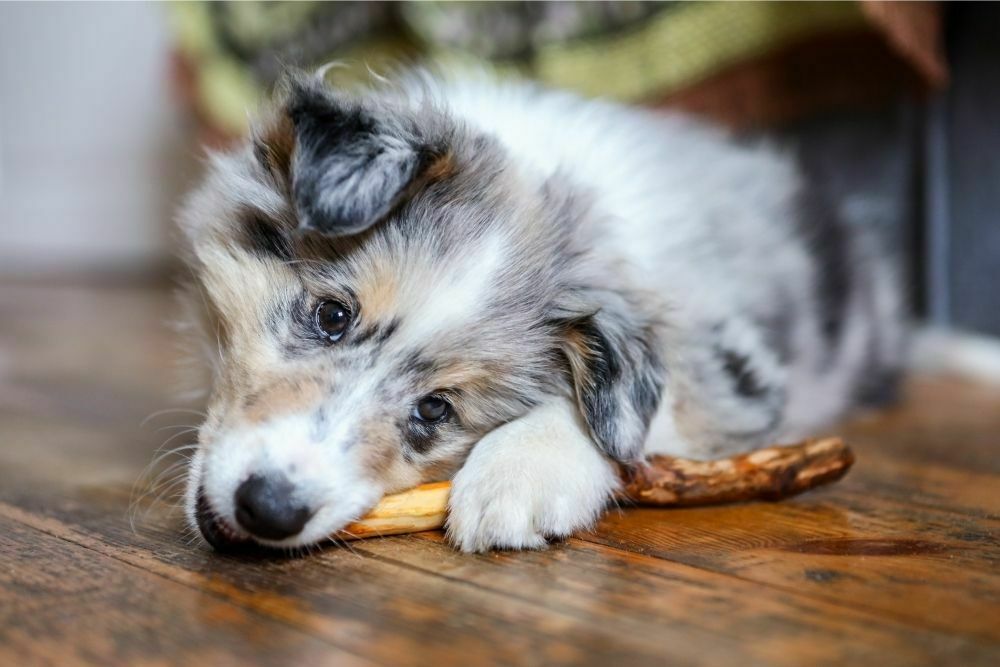
We have all been there, haven’t we? Walking through a pet store and seeing all the flashy toys and treats with no clue how to use them or how long your dog should be using them for. Perhaps you’ve been recommended a treat or toy by friends or the vet and are left wondering, how long should my puppy have that for?
You start to panic, wondering if you are cut out for this dog parent life and worry if you could inadvertently cause damage to your dog by giving them a dangerous toy or a toxic treat. One of these treats that causes panic is a bully stick.
You’ve probably heard of them and the controversy around them. Some dog owners love them, others think they are dangerous for your puppy, and then there’s you, unsure which way to turn and what side to take.
Well, we are here to remove the panic once and for all! We have put your questions to the test and return them to you today with the only answer you will ever need when it comes to bully sticks. We will tell you exactly how long your puppy should chew its bully stick and offer you all the information you need so you can buy your puppy treats with ease.
What are you waiting for? Just keep reading to find out more!
How Long Should A Puppy Chew on a Bully Stick?
Let’s get straight into it; your puppy should chew on your bully stick for roughly 5 to 10 minutes. This time period is considered a safe amount of time and should not cause any complications or issues for your puppy.
If you let your puppy chew the bully stick any longer, you can have some health complications. Before you panic, we have plenty of information about bully sticks’ dangers and health concerns; just keep reading for the information you need.
As bully sticks are high in protein, they can cause stomach problems for small puppies. The high protein content can be difficult for their little stomachs to digest in a short period of time, leaving them with stomach cramps or digestion issues that can become a long-term problem.
It takes roughly a year for your puppy’s digestive system to fully develop, meaning they can experience vomiting and diarrhea if they eat something that irritates them or they struggle to digest it. You will need to monitor not only their bully stick usage but all food that they eat.
Bully sticks can also damage a puppy’s teeth and gums if used excessively and can cause long-term dental problems that can leave you with expensive vet bills! Because of these risks, it’s best to limit the time your puppy spends chewing on a bully stick.
As we mentioned earlier, 5-10 minutes is plenty of time, and you can integrate other toys for them to chew if you wish. Keep an eye out for excessive chewing, or if your puppy is prone to dental issues, ensure that their time is limited to avoid causing any damage.
Is it dangerous for a puppy to chew on a bully stick?
While many of us are concerned about the choking hazard bully sticks present, there is no actual evidence that suggests they are harmful to your dog! In most cases, these sticks are the ideal treat to give your young dog!
However, as with all things, you should follow some general rules and guidance to ensure your puppy is safe and happy. Don’t worry; we will cover all of these and provide you with some tips about how much time your puppy should spend chewing their new treat!
As we mentioned earlier, excessive chewing of bully sticks can cause digestive problems and issues with their teeth and gums. While these can lead to long-term complications, providing you limit their usage to 5-10 minutes, you should not notice any issues with your puppy.
Ensure that you don’t let your puppy have a bully stick every day to prevent excessive chewing or swallowing too much of the stick. Instead, consider a few times a week or weekly, depending on the breed and size of the puppy.
However, if you do have any concerns, be sure to consult a professional who will be able to offer you advice tailored to your puppy and its specific set of needs.
Are bully sticks good for puppies?
Despite the health risks caused by excessive use, bully sticks are an excellent treat for your puppy! We all know that chewing is guaranteed to happen no matter the breed or temperament of the dog.
It’s how most of our puppies navigate the world, unknowingly destroying our homes. Shoes, socks, furniture, even the corners of walls are fair game to your puppy, and soon you find your favorite and most treasured possessions covered in teeth marks, or worse, destroyed.
That’s where bully sticks come in to save the day and your home! They allow your puppy to satisfy their need to chew without destroying your home! Not only this, but they also strengthen your puppy’s jaw and relieve teething pain. Remember to limit the time spent to avoid the excessive chewing motion that can be harmful to small dogs.
But bully sticks aren’t just good for relieving pain; they are also good for your dog’s health! In small quantities, most puppies can digest the bully stick with ease. Compared to rawhide bones and other treats, bully sticks do not splinter or break, so they won’t hurt your puppy as they eat them.
The sticks are also packed full of amino acids that aid in the healthy development of your puppy’s coat, body, and mind! They also help clean your puppy’s teeth, gradually scraping away any tartar or building up on their teeth. A few minutes with these daily sticks can help prevent any long-term dental issues and save you hefty vet bills!
What are bully sticks made from?
We apologize in advance for those currently enjoying a snack or lunch if you are putting off your food! Bully sticks are made from bull penises. No, you did read that right. Now the name makes sense, doesn’t it?
The meaty ingredient used in this treat is a healthy option for your puppy! Compared to other treats on the market, it is made without added preservatives, artificial colorings, sugars, and other ingredients that can cause havoc on our puppies’ tiny tummies.
While it does not sound appealing to most of us, they are a fantastic treat for your dog; just remember moderation due to the extremely high protein levels.

How are bully sticks made?
The manufacturing process differs depending on the brand, but bully sticks are generally made from the bull pizzle (penis muscle) that are drained of fluid, cleaned, stretched, and then cooked in a few different ways.
Commonly, bully sticks are smoked, baked, or sun-dried. Once cooked, they can be cut into different shapes or packaged as they are. The packaging depends largely on the brand and manufacturer, which is why we see so many kinds on the market.
You might see them under a few different names too. They are often called pizzle stickers, steer sticks, and bully sticks. You can pick them up at your local pet store or online, but be sure to check that it only contains beef to ensure its authenticity.
If you have any concerns about suitable treats for your puppy, remember to speak to a vet as they will be able to offer the best advice. Certain breeds have different needs that have to be met, and a vet will have the most accurate and up-to-date information for you!
Can bully sticks make your puppies overweight?
We all know that too many treats can cause anyone to gain weight (people and dogs alike), so we have to ensure that our puppies are given the correct amount of food to avoid causing any weight-related problems for them.
Generally speaking, though, bully sticks are relatively low in fat compared to other treats on the market! Most bully sticks on the market average around the 10% fat content mark, with the rest of their content being protein. Fantastic news for owners whose puppies tend to eat everything in sight!
Bully sticks might have a low-fat content, but their calorie content is on the larger side. The average bully stick contains roughly 88 calories, which is a large amount for dogs to eat in one go, especially small puppies.
It’s best only to give these treats to your pups occasionally. We would not recommend daily use; remember to limit their time to 5-10 minutes. You shouldn’t use these sticks as a substitute for meals or replacing healthier snacks. You can give your dog some fantastic snacks, including carrots, bananas, apples, and broccoli, but remember only to provide these in small quantities too!
Remember that the high protein content can overload a small digestive system and cause illness and other health problems down the line. For those after a good rule of thumb to follow, your puppies should not make up more than 10% of their diet.
10% of a diet will look different from puppy to puppy, depending on their breed or size. If you aren’t sure what their diet, let alone 10%, should look like, your vet can help you and offer specific recommendations for your dog’s breed.
Final Thoughts
And just like that, we have reached the end of our bully stick adventure today! Hopefully, now the recommendations from dog owners and treats you have walked past in stores make more sense to you!
These durable treats can provide your puppy with endless enjoyment and help make their chewing and teething phase more bearable for your puppy and your house! While these treats are popular, there is no ignoring the sheer volume of conflicting information online about them.
We hope we have offered you a safe space, free from that online, where you can get the information you need about bully sticks! Provided you limit the time your puppy chews on a bully stick and offer a well-rounded and balanced diet, with lots of running and cuddle time, your puppy is more than fine to chew on a bully stick!
Set a timer for 5-10 minutes and keep an eye on your new puppy while they chew away on their bully stick! Remember to take any queries or concerns to your vet so that you and your puppy can have a long and happy life together.
